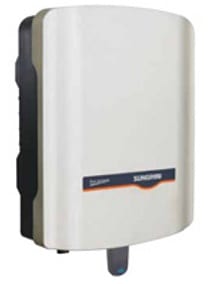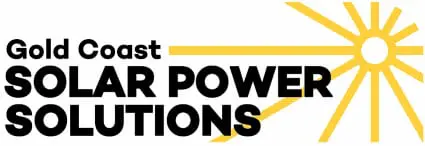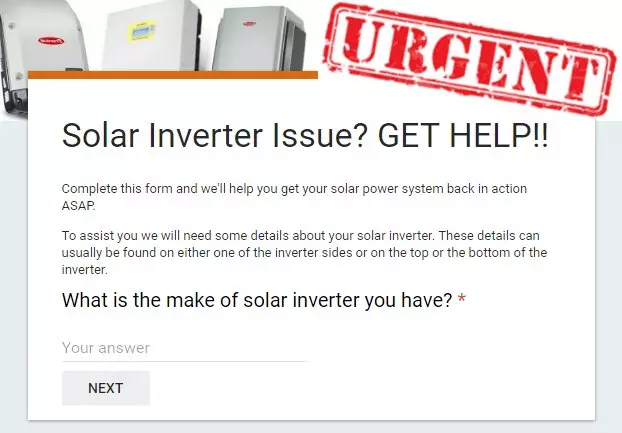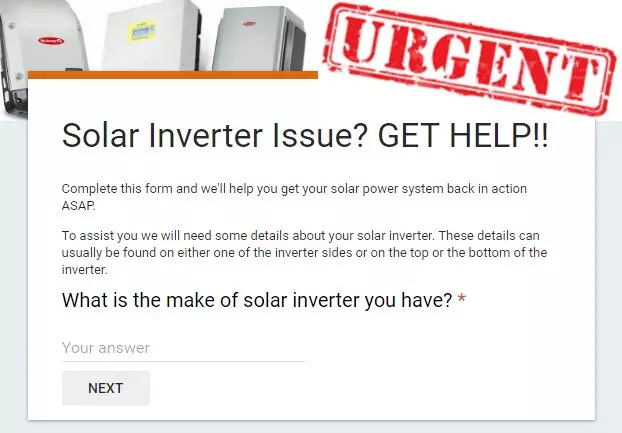 Sungrow KTL-D solar inverter is a good option if you happen to be on a tight budget. This Chinese solar inverter brand offers a standard 5-year warranty on parts and labor. The inverter also allows monitoring of real-time performance through your iPhone or Android phone with the SolarInfo Home App.
Sungrow KTL-D solar inverter is a good option if you happen to be on a tight budget. This Chinese solar inverter brand offers a standard 5-year warranty on parts and labor. The inverter also allows monitoring of real-time performance through your iPhone or Android phone with the SolarInfo Home App.
In case an issue comes up, we have put together a list of faults and solutions from Sungrow KTL-D Solar Inverter user manual. The list describes the fault code and the recommended troubleshooting procedures. When faults occur on the Sungrow KTL-D solar inverter, “Fault” state will be shown in the smartphone application interface.
Should you decide to follow the recommended actions, please note that safety measures should be observed to avoid any risk of injury. For further assistance fill out the following form.
|
Fault Code |
Description |
Troubleshooting |
| 0002 | The grid voltage exceeds inverter allowable upper limit. |
1. Check the voltage of the grid. 2. If the grid voltage exceeds the permissible range of inverter protection parameters, ask utility grid company for solution. 3. If the grid voltage is within the permissible range, contact Sungrow Service Dept. |
| 0003 | Grid transient voltage exceeds the permissible range |
1. This is a short-term fault due to grid condition. Wait a moment for inverter recovery. 2. If the fault still exists, please contact Sungrow Service Dept. |
| 0004 | The grid voltage is below inverter’s allowable lower limit. |
1. Check the grid voltage. 2. If the grid voltage exceeds the permissible range of inverter protection parameters, ask utility grid company for solution. 3. If the grid voltage is within the permissible range, contact Sungrow Service Dept. |
| 0005 | The grid voltage is too low. | 1. This is a short-term fault due to grid condition. Wait a moment for inverter recovery. 2. If the fault still exists, please contact Sungrow Service Dept. |
| 0006 | The AC output current exceeds inverter allowable upper limit. |
1. The inverter will resume if the output current falls below the protection value. 2. If the fault still exists, please contact Sungrow Service Dept. |
| 0007 | Transient AC overcurrent | 1. The inverter will self-recover after several seconds. 2. If the fault still exists, please contact Sungrow Service Dept. |
| 0008 | The grid frequency exceeds inverter allowable upper limit. | 1. Check the grid frequency. 2. If the grid frequency exceeds the permissible range of inverter protection parameters, ask utility grid company for solution. 3. If the grid frequency is within the permissible range, contact Sungrow Service Dept. |
| 0009 | The grid frequency is below the inverter allowable lower limit. | |
| 0010 | Islanding | 1. Check whether AC circuit breaker is triggered. 2. Check whether AC cables are all firmly connected. 3. Check whether grid is not in service. 4. If all conditions are OK and this fault still occurs in the LCD screen, contact Sungrow Service Dept. |
| 0011 | The DC component of AC current exceeds inverter limit. | 1. Wait a moment for inverter recovery. 2. If the fault occurs repeatedly, contact Sungrow Service Dept. |
| 0012 | A failure current is detected. | 1. Check the PV strings for ground fault. 2. If the fault occurs repeatedly, contact Sungrow Service Dept. |
| 0014 | The average grid voltage exceeds the permissible range for over 10 minutes. | 1. Wait a moment for inverter recovery. 2. Check the voltage of the grid. If the grid voltage exceeds the permissible range of inverter protection parameters, ask utility grid company for solution. 3. If the fault occurs repeatedly, contact Sungrow Service Dept. |
| 0015 | The grid voltage exceeds the permissible range | 1. Check the model of the AC cables. 2.Wait a moment for inverter recovery. 3. If the grid voltage exceeds the permissible range of inverter protection parameters, ask utility grid company for solution. 4. If the fault occurs repeatedly, contact Sungrow Service Dept. |
| 0016 | The bus voltage or power is high. | 1. Wait a moment for inverter recovery. 2. If the fault occurs repeatedly, contact Sungrow Service Dept. |
| 0019 | The transient bus voltage is high. | 1. Wait a moment for inverter recovery. 2. If the fault occurs repeatedly, contact Sungrow Service Dept. |
| 0020 | The bus voltage is high. | 1. Wait a moment for inverter recovery. 2. If the fault occurs repeatedly, contact Sungrow Service Dept. |
| 0021 | PV1 input overcurrent is detected | Check the layout and the wiring of PV1 input. |
| 0022 | PV2 input overcurrent is detected | Check the layout and the wiring of PV2 input. |
| 0036 | The temperature of radiator is too high. | 1. Check whether the placement of inverter is correctly. 2. Check whether the inverter operating ambient temperature is more than the range indicated in the specification. 3. Check whether the AC output power exceeds the nominal power. 4. If the fault still exists, please contact Sungrow. |
| 0037 | The internal temperature of inverter is too high | |
| 0038 | Relay fault is detected | 1. Wait a moment for inverter recovery. 2. If the fault occurs repeatedly, contact Sungrow Service Dept. |
| 039 | The insulation resistance is low. (ISO-flt) | 1. Check whether the positive and negative of PV panels is short-circuited with ground lead. 2. Wait a moment for inverter recovery. 3. If the fault occurs repeatedly, contact Sungrow Service Dept. |
| 041 | Leakage current self-test abnormality | 1. Wait a moment for inverter recovery. 2. If the fault occurs repeatedly, contact Sungrow Service Dept. |
| 047 | The PV configuration mode set in the phone application interface is not in accordance with the configuration in the connection cabinet. | 1. Disconnect the inverter. 2. Re-select PV configuration mode and re-connect PV strings. |
| 048 | Sampling channel failure | 1. Wait a moment for inverter recovery. 2. If the fault occurs repeatedly, contact Sungrow Service Dept. |
| 053 | Auxiliary DSP detects grid voltage exceeds set protection value | 1. Check the grid voltage. 2. If the grid voltage exceeds the permissible range of inverter protection parameters, ask utility grid company for solution. 3. If the grid voltage is within the permissible range, contact Sungrow Service Dept. |
| 054 | Auxiliary DSP detects grid frequency exceeds set protection value | 1. Check the grid frequency. 2. If the grid frequency exceeds the permissible range of inverter protection parameters, ask utility grid company for solution. 3. If the grid frequency is within the permissible range, contact Sungrow Service Dept. |
| 056 | Auxiliary DSP detects grid leakage current exceeds set protection range | 1. Check whether there is a grounded fault of the PV string. 2. If the fault occurs repeatedly, contact Sungrow Service Dept. |
| 057 | Auxiliary DSP AC current sampling channel anomaly | 1. Wait a moment for inverter recovery. 2. If the fault occurs repeatedly, contact Sungrow Service Dept. |
| 058 | Auxiliary DSP detects AC current DC injection exceeds inverter set protection range | 1. Wait a moment for inverter recovery. 2. If the fault occurs repeatedly, contact Sungrow Service Dept. |
| 059 | Main and auxiliary DSP communication anomaly | 1. Wait a moment for inverter recovery. 2. If the fault occurs repeatedly, contact Sungrow Service Dept. |
| 060 | Main and auxiliary DSP sampling difference | 1. Wait a moment for inverter recovery. 2. If the fault occurs repeatedly, contact Sungrow Service Dept. |
| 070 | Fans are defective | Stop the inverter and disconnect the AC and DC cables. Check whether the fan duct has been blocked. If not, replace fans. |
| 087 | Arc self-detection anomaly warn | Wait a while. Contact Sungrow if device is still in self-detection warn state. |
| 088 | Arc anomaly fault | 1. Stop the inverter and disconnect the AC and DC cables. Check cable connection for aging and looseness. Re-power on and remove the arc warn manually. 2. Contact Sungrow if this fault still occurs. |
| 089 | Arc detection OFF warn | Remove the warn by enable arc detection function or keep the warn by closing arc detection function. |
| 100 | The AC output current exceeds inverter protection limit. |
1. The inverter will resume if the output current falls below the protection value. 2. If the fault still exists, please contact Sungrow Service Dept. |
| 101 | The grid frequency exceeds inverter allowable upper limit. | 1. Check the grid frequency. 2. If the grid frequency exceeds the permissible range of inverter protection parameters, ask utility grid company for solution. 3. If the grid frequency is within the permissible range, contact Sungrow Service Dept. |
| 102 | The grid frequency is below the inverter allowable lower limit. | |
| 106 | The inverter is not grounded | Check whether there is a reliable inverter grounding line, if thre is access to the ground, and the fault still exists, please contact Sungrow Service Dept. |
| 200 | The bus voltage is high. | 1. Wait for inverter recovery after bus voltage lower. 2. If the fault occurs repeatedly, contact Sungrow Service Dept. |
| 201 | The bus voltage is too low. | 1. Wait a moment for inverter recovery. 2. If the fault occurs repeatedly, contact Sungrow Service Dept. |
| 202 | PV current overcurrent | 1. Wait for inverter recovery after DC current is reduced. 2. If the fault occurs repeatedly, contact Sungrow Service Dept. |
| 205 | AC output replay abnormal | 1. Wait a moment for inverter recovery. 2. If the fault occurs repeatedly, contact Sungrow Service Dept. |
| 307 | DC power is too high | Check whether the configuration of PV is in the range indicated in the specification. If the fault occurs repeatedly, contact Sungrow Service Dept. |
For the full details check the Sungrow KTL-D solar inverter manual’s Troubleshooting section. Should you follow the troubleshooting steps above but the issue is not fixed on your Sungrow KTL-D solar inverter check if it’s still within the warranty period so you can contact the equipment installer or supplier. Be ready with the serial number, fault name and code with a brief description of the fault.
If your Sungrow KTL-D solar inverter is outside the warranty period we suggest that you contact a professional solar power expert. If you need further assistance please enter your details in the following form.

Got A Question About Solar Power?
- Can you add more solar panels to your solar power system?
- How much power can you expect from your solar power system?
- Do you know how to read your Energex solar power meter?
- How to make the most of the 44c feed in tariff
- How to make the most out of a low feed in tariff



